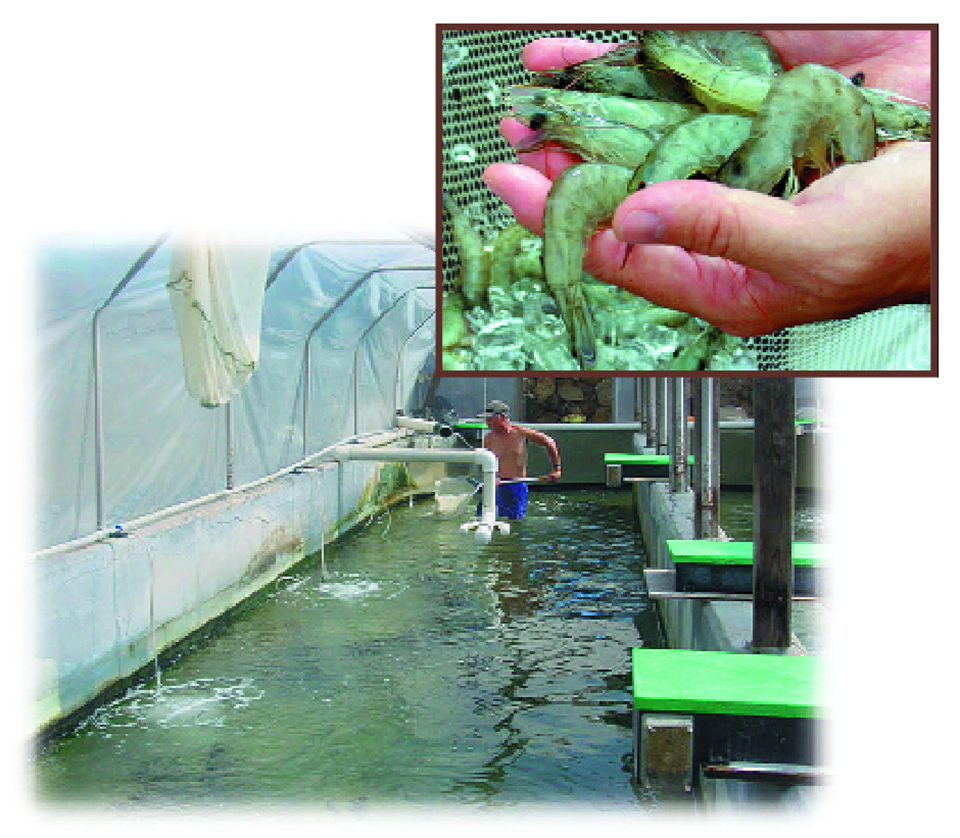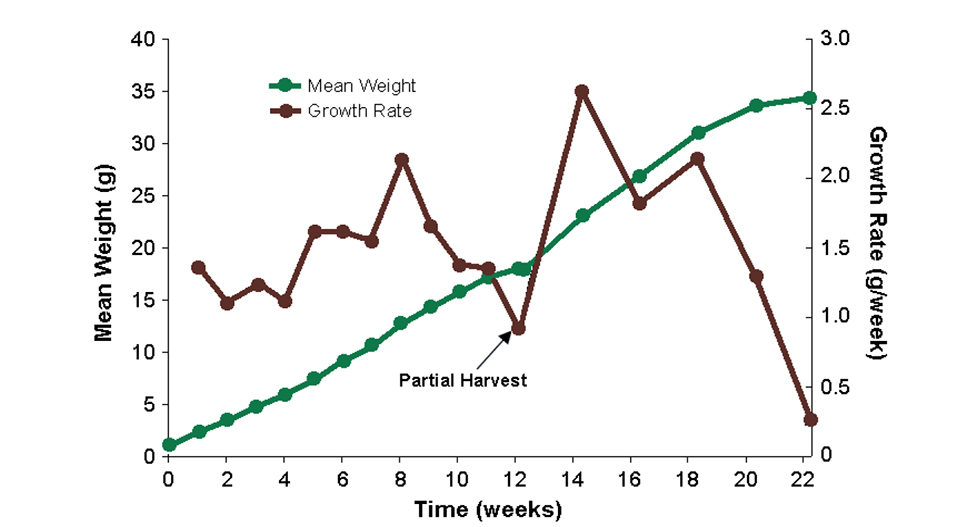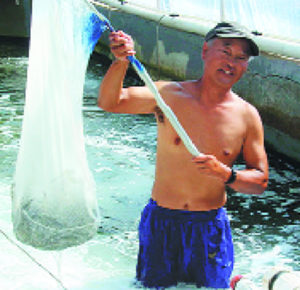Optimizing strategies for growing larger L. vannamei

Although the giant tiger prawn (Penaeus monodon) is the most common shrimp species cultured in Asia, its dominance has faded in recent years as many Asian farmers stocked their ponds with Pacific white shrimp (Litopenaeus vannamei). Now more L. vannamei are produced in Asia than the Western Hemisphere, contributing to a glut of white shrimp and significant drops in shrimp prices.
Alternative production strategies
Shrimp farmers in the United States and elsewhere are considering alternative production and harvesting strategies to avoid direct competition with foreign imports from Asia, including the production of larger white shrimp. However, there is little published information on growth curves and feeding rates for larger L. vannamei, and even less information on optimal harvesting strategies.
O.I. research
In an attempt to grow large shrimp at high densities under biosecure conditions, researchers at the Oceanic Institute stocked specific pathogen-free juvenile L. vannamei in a 58.4-square meter raceway (Fig. 1) at a density of 705 shrimp per cubic meter. After 86 days, shrimp survival in the phase 1 study was 70.3 percent, mean harvest weight was 17.9 grams, and mean growth rate was 1.37 grams per week (Table 1). Production was 8.9 kilograms per cubic meter, with mean water exchange throughout the trial of less than 2 percent per day.
Moss, Performance of L. vannamei grown in a raceway, Table 1
| Parameter | Phase 1 Trial | Phase 2 Trial |
|---|---|---|
| Stocking density (shrimp/m3) | 705 | 118 |
| Trial duration (days) | 86 | 69 |
| Stocking weight (g) | 1.06 | 17.90 |
| Harvest weight (g) | 17.9 | 34.20 |
| Survival (%) | 70.3 | 87.80 |
| Growth rate (g/week) | 1.37 | 1.65 |
| Production (kg/m3) | 8.9 | 3.50 |
| Water use (l/kg shrimp) | 219 | 229 |
Immediately following the first harvest, about 24 percent of the harvested shrimp were restocked into the raceway, which contained 55 percent of the original water, at 118 shrimp per cubic meter. In this phase 2 work, shrimp survival was 87.8 percent after 69 days, mean harvest weight was 34.2 grams, and mean growth rate was 1.65 grams per week.
During the second grow-out phase, shrimp exhibited sexual growth dimorphism. Females grew 1.88 grams per week and were harvested at 36.9 grams, whereas males grew 1.42 grams per week and were harvested at 31.5 grams. The trial indicated shrimp can be grown to 34.2 grams in 155 days at high densities with minimal water use.
Compensatory growth
Interestingly, weekly growth rates increased from 0.95 grams during week 12, immediately prior to the first harvest, to 2.6 grams during the first two weeks after the initial harvest (Fig. 1). This dramatic increase suggested that L. vannamei may exhibit compensatory growth.

Compensatory growth occurs when an organism exhibits faster than normal growth during a period of recovery from growth restriction. In some fish, compensatory growth can be so intense that starved and refed individuals exhibit higher mean growth rates than those fed continuously.
In this case, growth restriction likely resulted from the high stocking density, as growth is density-dependent in penaeid shrimp. Earlier work at the Oceanic Institute showed that L. vannamei exhibit a rapid and significant increase in RNA concentration and RNA/DNA ratio following the reintroduction of feeding after several days of starvation. However, this was the first indication that the species may exhibit compensatory growth when relieved of density pressure.
Optimal harvesting

From a farm management perspective, it may be possible to exploit this compensatory growth through partial harvesting strategies to increase production and profitability.
A partial budget analysis conducted by the Oceanic Institute using data from the grow-out trial indicated that partial harvesting was 8.8 percent more profitable than a single harvest if phase 2 shrimp were harvested after four weeks. In contrast, if phase 2 were harvested after 10 weeks, there would have been a 5.9 percent loss in net revenue compared to a single harvest. In this case, the increase in yield for partial harvesting did not compensate for the opportunity loss of running more regular cycles.
The partial budget analysis used a unit of analysis of a single raceway and assumed 3.87 crops per year for the single-harvest scenario, 3.01 crops for the four-week phase 2 approach, and 2.25 crops with a phase 2 of 10 weeks. Prices for head-off shrimp with 2:1 tail per head ratios were based on prices from U.S. $2.58 per pound for 36 per 40 shrimp to $6.50 per pound for UN per 15 shrimp. Feed cost was assumed to be $0.70 per kilogram, with other costs considered similar among the scenarios. Partial harvesting would increase harvesting costs somewhat.
Although this analysis suggested partial harvesting can be beneficial, the strategy has not been optimized. Growth curves and feeding rates for larger shrimp under different production scenarios are needed to develop efficient harvest models. Ultimately, these models can be used by farmers to increase production and improve profitability.
(Editor’s Note: This article was originally published in the October 2005 print edition of the Global Aquaculture Advocate.)
Now that you've finished reading the article ...
… we hope you’ll consider supporting our mission to document the evolution of the global aquaculture industry and share our vast network of contributors’ expansive knowledge every week.
By becoming a Global Seafood Alliance member, you’re ensuring that all of the pre-competitive work we do through member benefits, resources and events can continue. Individual membership costs just $50 a year. GSA individual and corporate members receive complimentary access to a series of GOAL virtual events beginning in April. Join now.
Not a GSA member? Join us.
Authors
-
Shaun M. Moss, Ph.D.
The Oceanic Institute
41-202 Kalanianaole Highway
Waimanalo, Hawaii USA[103,114,111,46,101,116,117,116,105,116,115,110,105,99,105,110,97,101,99,111,64,115,115,111,109,115]
-
PingSun Leung, Ph.D.
Department of Molecular Biosciences and Bioengineering
University of Hawaii at Manoa
Honolulu, Hawaii USA
Tagged With
Related Posts

Responsibility
Aquaculture gives endangered totoaba a fighting chance
The tenuous fate of a pint-sized porpoise, the critically endangered vaquita, is linked to a fish targeted by poachers fueling China’s appetite for maws. The vaquita remains in peril, but aquaculture presents some hope for the totoaba.

Intelligence
Bangladesh seeks more buck for its ‘bagda’
As more than 80 percent of Bangladeshi shrimp exports already go to EU markets, a consultation meeting involving buyers from the bloc and Bangladesh industry stakeholders and authorities was held at the end of last month in Utrecht, the Netherlands.

Health & Welfare
Biosecurity practices on fish farms need beefing up
Biosecurity measures and preventive strategies are essential in any biological production chain. Properly planned and implemented biosecurity programs will enhance animal health, production and economics.

Health & Welfare
Building a better shrimp nursery, part 1
Shrimp nursery systems offer an important opportunity to increase profits. Properly designed and operated nurseries are highly biosecure facilities to grow postlarvae at very high densities.


